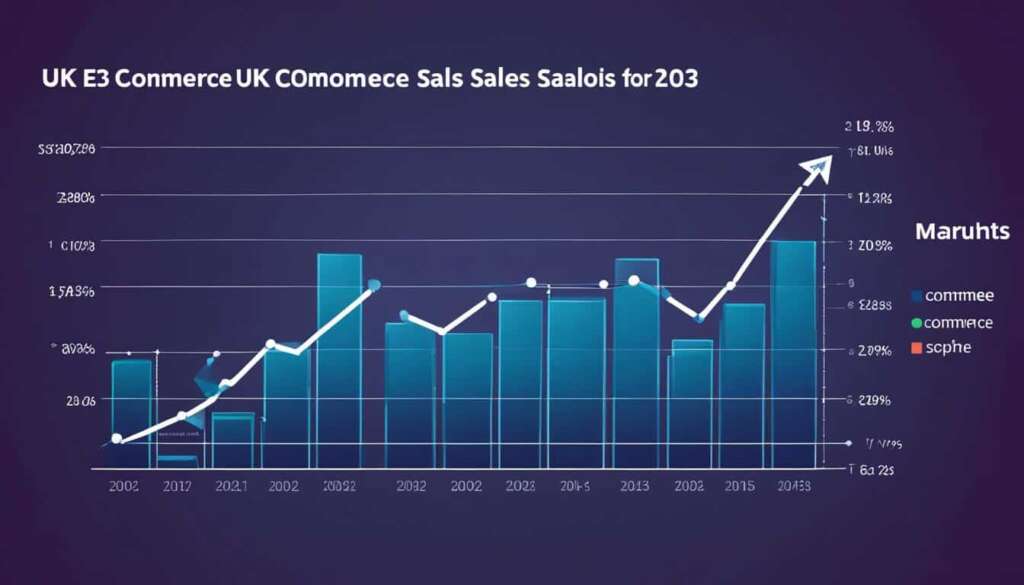Table of Contents
Welcome to our guide on the e-commerce landscape in the United Kingdom. In this article, we will explore the latest market trends and provide valuable insights into the digital shopping scene in the UK.
With the third largest e-commerce market in the world, the UK offers tremendous opportunities for businesses in the online retail space. E-commerce revenues in the UK are expected to grow at an annual average rate of 12.6% by 2025, showcasing the immense potential for growth.
Currently, consumer e-commerce accounts for 36.3% of the total retail market in the UK, with projected revenue of $285.60 billion by 2025. The UK witnessed a remarkable 36% increase in online sales in 2022, the highest annual growth since 2007.
Leading the way in the UK e-commerce market is Amazon.co.uk, followed by Sainsburys.co.uk and Tesco.com. The top-selling products and services in this digital landscape include fashion, electronics, toys, and food and beverages, among others.
The rise of social media marketing and the ubiquity of mobile internet access have contributed significantly to the growth of e-commerce in the UK. Consumers in the UK are increasingly turning to online platforms to find the best deals and prices, driving the surge in online spending.
While online sales flourish, physical retail stores have faced stagnation. However, by adapting to the e-commerce landscape and leveraging digital strategies, businesses can position themselves for success in this competitive market.
Stay tuned for the upcoming sections as we delve deeper into the market size and growth, consumer behavior and legal environment, as well as the impact of COVID-19 on e-commerce in the UK. Let’s explore the exciting world of online retail in the United Kingdom together.
E-commerce Market Size and Growth in the UK
The United Kingdom e-commerce market has witnessed significant growth in recent years, positioning itself as a major player on the global stage. The market size is projected to reach USD 230.41 billion in 2023 and is expected to maintain robust growth, with a compound annual growth rate (CAGR) of 21.76% to reach USD 616.62 billion by 2028.
E-commerce has been on the rise in the UK, driven by investments from internet-focused enterprises and the transition of sellers from traditional brick-and-mortar stores to online platforms. While traditional retail sales have stagnated, revenues from regional online shopping have soared, contributing to the rapid expansion of the e-commerce market.
The United Kingdom’s e-commerce landscape is characterized by a diverse range of players vying for market share. Some of the prominent e-commerce platforms in the UK include Amazon UK, eBay UK, Asos, Currys PC World, and Gumtree. This fragmentation signifies the competitiveness and opportunities present in the market.
The growth of the e-commerce industry has also spurred the development of distribution centers across the country, ensuring efficient logistics and fulfillment to meet the increasing demands of online consumers. These distribution centers have played a pivotal role in enabling seamless delivery and enhancing customer satisfaction.
E-commerce Market Players in the UK
| Company | Market Share |
|---|---|
| Amazon UK | 25% |
| eBay UK | 17% |
| Asos | 8% |
| Currys PC World | 5% |
| Gumtree | 4% |
Source: Market Research Report
Consumer Behavior and Legal Environment in UK E-commerce
When it comes to e-commerce in the UK, consumers exhibit distinctive behavior patterns influenced by factors such as convenience, price comparison, and product variety. The British market has seen a significant shift towards online shopping, with fashion, health and beauty, consumer electronics, travel services, and home and garden products being the most popular categories.
One prevalent trend among UK consumers is the practice of physically inspecting or trying out products in-store and then making purchases online or through mobile devices to secure better prices. This behavior reflects the importance of price sensitivity and the drive to find the best deals.
Another emerging trend is the increasing popularity of click and collect services. Consumers appreciate the flexibility of being able to order products online and collect them at their convenience from designated pickup points. This option combines the convenience of online shopping with the immediacy of receiving products.
When it comes to payment methods, UK-based online businesses generally accept credit or debit cards, with Visa and MasterCard being widely used. Additionally, services such as PayPal have gained popularity as a convenient and secure way of making online transactions.
Table:
| Preferred Payment Methods | Percentage of UK Online Shoppers |
|---|---|
| Credit/Debit Cards | 72% |
| PayPal | 28% |
| Other Payment Methods | 10% |
The legal and regulatory environment for UK e-commerce is governed by various statutes and regulations, safeguarding consumer rights and ensuring fair trading practices. Key legislations include the Consumer Rights Act 2015, the Consumer Contracts Regulations 2013, and the Consumer Protection from Unfair Trading Regulations 2008. These regulations aim to provide protection against deceptive practices, ensure transparency in transactions, and safeguard against unfair treatment.
Furthermore, the EU’s General Data Protection Regulation (GDPR) has been in effect in the UK, protecting personal data in the context of e-commerce transactions and establishing guidelines for businesses to handle customer information responsibly.
Understanding consumer behavior and adhering to legal obligations are crucial for success in the UK e-commerce market. By catering to consumer preferences and complying with regulations, businesses can build trust, enhance customer satisfaction, and navigate the legal environment effectively.

Impact of COVID-19 on E-commerce in the UK and Key Trends
The COVID-19 pandemic has had a profound impact on the retail industry in the United Kingdom, leading to the closure of nonessential retail stores and a significant shift in consumer shopping behaviors. As social distancing measures and lockdown restrictions were implemented, consumers turned to e-commerce platforms to fulfill their shopping needs.
The unprecedented circumstances caused by the pandemic have accelerated the growth of e-commerce, making it the fastest-growing segment of the retail market in Europe. Despite the challenging economic conditions, the UK e-commerce market has remained resilient, with online sales playing a vital role in sustaining the retail sector. In fact, online sales have accounted for a significant portion of total retail sales during this time.
While the growth rate of e-commerce conversions may have slowed when compared to previous years, consumers continue to actively make online purchases, indicating a sustained demand for digital shopping experiences. The convenience and safety of online shopping have become increasingly appealing in the face of uncertainty.
Several key trends have emerged in the UK e-commerce market as a result of the pandemic. Firstly, the use of mobile devices for online shopping has become paramount. Smartphones have become the primary device for browsing and purchasing products, highlighting the importance of mobile optimization for e-commerce businesses.
Additionally, video marketing has gained prominence as a powerful tool for engaging consumers and driving sales. With the increase in online shopping, video content offers a dynamic and engaging way for brands to showcase their products and connect with their target audience.
Sustainability has also become a significant trend in the UK e-commerce market. Consumers are increasingly conscious of the environmental impact of their purchasing decisions and are actively seeking out eco-friendly products and practices. E-commerce businesses that prioritize sustainability and promote eco-friendly initiatives are well-positioned to capture the attention and loyalty of environmentally conscious consumers.
Key Trends in UK E-commerce:
- Mobile optimization for seamless online shopping experiences on smartphones
- Video marketing as a powerful tool for product showcasing and brand engagement
- Consumer preference for sustainable and eco-friendly products and practices
As the e-commerce landscape continues to evolve, businesses in the United Kingdom must adapt to these trends to stay competitive in the market. By prioritizing mobile optimization, leveraging video marketing strategies, and embracing sustainability, e-commerce brands can position themselves as leaders in the industry and capture the attention of discerning consumers.
Conclusion
The e-commerce market in the UK is experiencing rapid growth, presenting significant opportunities for businesses. To thrive in this competitive market, it is crucial for businesses to adopt the right strategies and focus on key trends. Mobile optimization, video marketing, and sustainability are key factors to consider when establishing an online presence.
Despite the challenges brought about by COVID-19, e-commerce in the UK has demonstrated resilience and continues to dominate the retail industry. Online sales have proven to be a vital component of total retail sales, making it essential for businesses to adapt to changing consumer behavior and technological advancements.
To succeed in the UK e-commerce market, it is essential for businesses to stay up-to-date with the latest trends and continuously adapt their strategies. By keeping a finger on the pulse of consumer behavior and implementing innovative approaches, businesses can position themselves for success in this dynamic market. The future of e-commerce in the UK holds great promise, and businesses that embrace this digital landscape have the potential to achieve long-term growth and success.
FAQ
What is the size of the e-commerce market in the UK?
The UK has the third largest e-commerce market in the world after China and the U.S. The United Kingdom e-commerce market size is expected to reach USD 230.41 billion in 2023 and is projected to grow at a CAGR of 21.76% to reach USD 616.62 billion by 2028.
What are the top e-commerce products/services in the UK?
The top e-commerce products/services in the UK include fashion, electronics, toys, and food and beverages.
Who are the leading players in the UK e-commerce market?
Amazon.co.uk is the leading player in the UK e-commerce market, followed by Sainsburys.co.uk and Tesco.com.
How has COVID-19 impacted the e-commerce market in the UK?
COVID-19 has had a significant impact on the retail industry, forcing the closure of nonessential retail stores and driving consumers to shift their shopping habits online. The pandemic has accelerated the growth of e-commerce, making it the fastest-growing segment of the retail market in Europe. Despite the challenging economic conditions, the UK e-commerce market has remained resilient, with online sales accounting for a significant portion of total retail sales.
What are the key trends in the UK e-commerce market?
Mobile devices, video marketing, and sustainability are among the key trends in the UK e-commerce market. Mobile optimization is crucial, as smartphones are the primary device for online shopping. Product reviews and eco-friendly practices also play a significant role in consumer purchasing decisions.







